It’s been 80 years since Northern Norway began being liberated from Nazi German occupation, but the celebrations aren’t what they used to be. Traditional versions of how Russian troops marched over the border east of Kirkenes and launched the liberation of Finnmark are also being challenged, as relations between Norway and today’s Russia hit the freezing point.
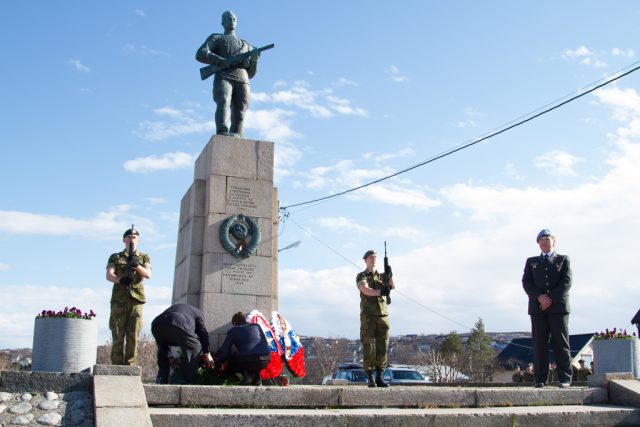 In earlier days, joint liberation ceremonies here in Kirkenes included officials from both Russia and Norway, like here in 2016, but not any longer. PHOTO: Forsvaret/Marcus Haaland
In earlier days, joint liberation ceremonies here in Kirkenes included officials from both Russia and Norway, like here in 2016, but not any longer. PHOTO: Forsvaret/Marcus Haaland
Memorial ceremonies were still held in Kirkenes on Friday, 80 years since it was indeed liberated by the former Red Army on October 25, 1944. This year there were two separate ceremonies, however, instead of the former joint memorial often attended by high-ranking Norwegian and Russian officials including King Harald V just five years ago. Russian officials were not invited to the Norwegians’ morning ceremony on Friday, led by elected officials in Kirkenes’ administrative region of Sør-Varanger, so they held their own later in the day.
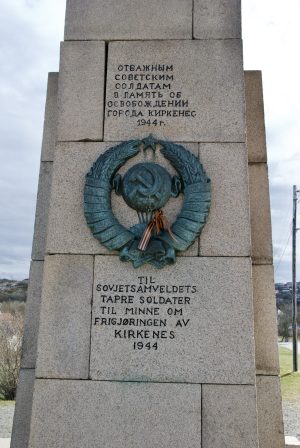 The monument in Kirkenes reads, in both Russian and Norwegian: “To the Soviet Union’s brave soldiers, in memory of the liberation of Kirkenes, 1944 PHOTO: NewsinEnglish.no/Morten Møst
The monument in Kirkenes reads, in both Russian and Norwegian: “To the Soviet Union’s brave soldiers, in memory of the liberation of Kirkenes, 1944 PHOTO: NewsinEnglish.no/Morten Møst
Both sides honoured all those killed during the war and especially those who died or were wounded locally. They also recognized their “shared history” that survived through the Cold War and beyond. Norwegian Broadcasting (NRK) reported how the mayor of Sør-Varanger hailed those “who fought for our freedom and sacrificed everything.” Russia’s general consul (who’s still in Kirkenes even though the consulate itself has closed) spoke in both Norwegian and Russian about how “thousands of Soviet citizens lost their lives” and how it’s “our moral obligation” to preserve and pass on “our common history” to future generations. (See coverage from the Kirkenes-based Barents Observer here.)
Since Russia’s full-scale invasion of Ukraine in February 2022, however, there are vastly different views regarding the need to recognize national borders, challenge authoritarian leaders and avoid creating enemies. State secretary Eivind Vad Petersson of the foreign ministry in Oslo said it was no longer possible to have a joint memorial with Russia after it launched war against one of its own neighbours.
“At the same time, it’s important to show gratitude to the Red Army and what happened during the liberation,” Petersson said.
There are, meanwhile, changing views on the liberation itself. In a lengthy article in newspaper Aftenposten on Friday, a professor at Norway’s defense college (Forsvarets høyskole) and a leader of Norway’s defense museums were careful to restrict the liberation to the region of Sør-Varanger and not all of Finnmark. They also stressed how it was carried out not just by Russians but by “multi-ethnic members” of the Soviet Union’s Red Army. “There was an abundance of nationalities represented among the (Red Army’s) soldiers,” wrote Professor Sven G Holtsmark and Lars Rowe, noting that Ukrainians made up as much as 20 percent of the Red Army in the fall of 1944.
They also cited “extensive source material” from Russian officer Kirill A Meretskov’s Karelske front at the time, where the 14th army was one of several divisions, and documentation from former Russian leader Josef Stalin’s core staff, Stavka. It reveals that the Red Army was mostly keen on securing important mines for nickle production in northern areas east of Norway’s border, that Hitler’s forces were already moving out, and that the Red Army had intended to stop their offensive at the Norwegian border, to which German forces were retreating.
Holtsmark and Rowe also wrote that Hitler had ordered German forces on October 3 (four days before the Soviet offensive began) to move all the way west and south to Lyngen in Norway, where they had major military installations. “The remaining German forces’ defense against the 14th (Red) army therefore wasn’t meant to hold on to territory,” they wrote, “but to secure an organized retreat with the lowest possible level of losses among soldiers and military equipment.”
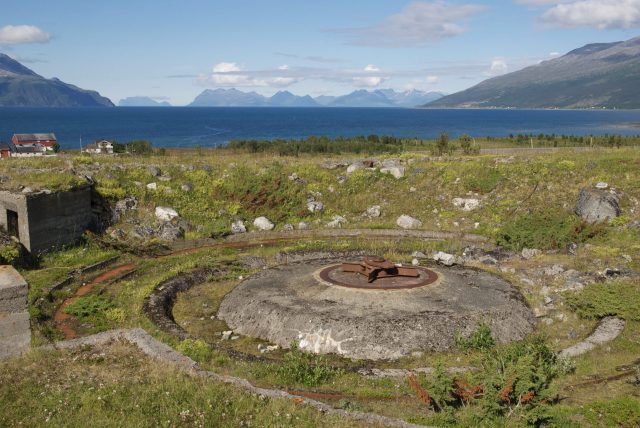 Remains of Nazi German military fortifications can still be seen here at Lyngen, southwest of Kirkenes. The Germans burned and otherwise destroyed much of their own facilities and entire towns and communities during their retreat from Northern Norway in 1944-45. PHOTO: NewsinEnglish/Morten Møst
Remains of Nazi German military fortifications can still be seen here at Lyngen, southwest of Kirkenes. The Germans burned and otherwise destroyed much of their own facilities and entire towns and communities during their retreat from Northern Norway in 1944-45. PHOTO: NewsinEnglish/Morten Møst
The two Norwegian historians contend Soviet generals were not aware that the Germans were already pulling out of the area both east and west of the Pasvik valley where Norway’s border runs. The Red Army pressed forward regardless and ended up crossing the border and pushing German forces out of Sør-Varanger, but stress that the Red Army did not put “200,000 German soldiers on the run,” Holtsmark and Rowe argue. “The German retreat, first from Finnish Lappland and then from Petsamo and all of Finnmark, was ordered before the Soviet offensive began.”
They also argue that there was no Soviet goal to liberate Norwegian territory. “The plan was to conquer what’s now Soviet territory and destroy the German forces that posed a threat in the area,” Holtsmark and Rowe wrote. They also stress that the Red Army “didn’t liberate Finnmark, nor did they liberate Eastern Finnmark … the Red Army liberated Sør-Varanger, (just) one of Finnmark’s 18 municipalities.”
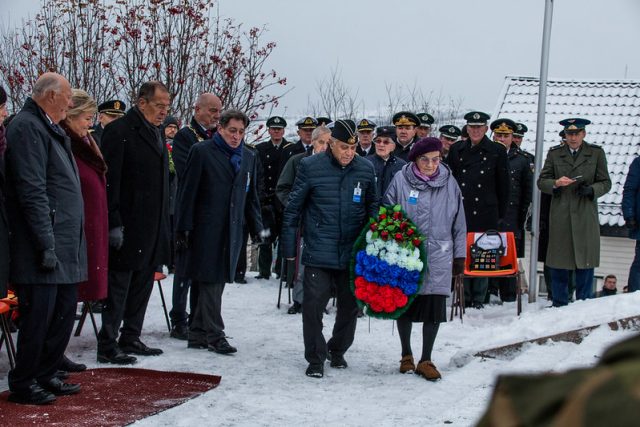 Russians and Norwegians joined together, at very high levels, in memorials to the liberation of Sør-Varanger on October 25 as late as 2019. Here, from left: Norway’s King Harald V, former prime minister Erna Solberg, Russian Foreign Minister Sergey Lavrov and Russia’s ambassador to Norway, Teymuraz Ramishvili. PHOTO: Statsministerens kontor
Russians and Norwegians joined together, at very high levels, in memorials to the liberation of Sør-Varanger on October 25 as late as 2019. Here, from left: Norway’s King Harald V, former prime minister Erna Solberg, Russian Foreign Minister Sergey Lavrov and Russia’s ambassador to Norway, Teymuraz Ramishvili. PHOTO: Statsministerens kontor
Holtsmark and Rowe stress that there’s no doubt the Soviets did indeed liberate a portion of Norwegian territory towards the end of World War II “and we shall, with no reservations, honor the Soviet soldiers who lost their lives on Norwegian soil. We shall also honour the many millions of their comrades who fell, and the millions more Soviet civilians who were murdered or died in the fight against Naziism.” They added, though, that “for those of us concerned about history and our relation to history, it’s time for new-thinking and some soul-searching.”
Many citizens of Kirkenes remain grateful, and wish relations with Russians just over the border were better. Everyone living within 30 kilometers of the border used to be able to cross without visums and work together on projects ranging from business ventures to sporting events. King Harald had declared on October 25 just five years ago (at ceremonies attended by former Prime Minister Erna Solberg, her foreign minister Ine Eriksen Søreide and Russian Foreign Minister Sergey Lavrof) that “we don’t just share a border here in the north. We also share interests and hope for the future.”
Russian President Vladimir Putin dashed such hopes with his invasion of Ukraine. That’s also led to ongoing diplomatic quarreling between Norway and Russia, expulsions of diplomats in both Oslo and Moscow, the closure of the consulate in Kirkenes last week (external link to the Barents Observer) and the split ceremonies on the 80th anniversary of the area’s liberation. Norway also closed its diplomatic mission in Murmansk in 2022, after Russia’s invasion of Ukraine, but retains a consulate in St Petersburg.
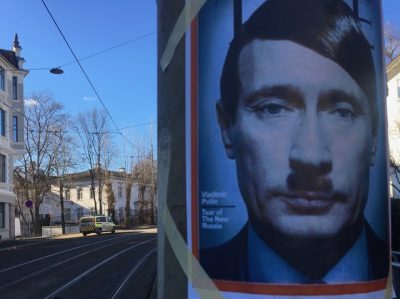 Now the Russia Embassy in Oslo (at left in background) is the site of frequent demonstrations and ongoing protests, including this poster of Russian President Vladimir Putin portrayed as a new Hitler. PHOTO: NewsInEnglish.no/Morten Møst
Now the Russia Embassy in Oslo (at left in background) is the site of frequent demonstrations and ongoing protests, including this poster of Russian President Vladimir Putin portrayed as a new Hitler. PHOTO: NewsInEnglish.no/Morten Møst
Norway’s recent decision that more Russian employees at Russia’s embassy in Oslo must travel home sparked a sharp rebuke last week from the Russian foreign ministry’s spokeswoman Maria Zakharova. She claimed that “Oslo’s new demand will paralyze Russian diplomatic activity in Norway in several areas,” and threatened that Russia “will respond in an extremely painful manner,” without elaborating on what that may mean.
Ragnhild Simenstad of Norway’s foreign ministry denied further expulsions and wouldn’t specify how many diplomats are left at the Russian Embassy. “We are in a serious security policy situation as a result of Russia’s illegal attacks on Ukraine,” Simenstad told newspaper Aftenposten, adding that “even though we’re neighbouring countires, we have little contact today.”
Meanwhile, Russia’s long-term ambassador in Oslo who’d arrived in 2016, Teymuraz Ramishvili, has been replaced by Nikolai Korchunov, who specializes in Arctic affairs (external link to the Barents Observer). Russia has long been keen on expansion in the Arctic and on gaining more influence on Svalbard, which is under Norwegian jurisdiction. Korchunov’s appointment was effective from October 1, but the Norwegian foreign ministry’s “Order of Precedence” among ambassadors in Oslo still showed the Russian Embassy as led by a charge d’affaires this week.
NewsinEnglish.no/Nina Berglund